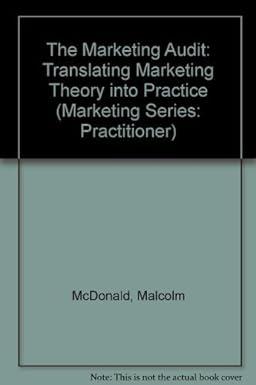Question
For the following independent situations, assume that you are the audit partner on the engagement: 1. The client recorded impairment of goodwill for $40,000 last
For the following independent situations, assume that you are the audit partner on the engagement:
1. The client recorded impairment of goodwill for $40,000 last year. It recorded reversal of impairment in goodwill for $20,000 this year after considering the carrying amount and recoverable amount of the cash generating unit. Net income is $10,000 in current year.
2. Company A has 20% inventory held by Just Department Store on a consignment basis. Confirmation request was not allowed to be sent to Just Department Store by Company A. You were only given the consignment agreement. Inventory represents 30% of the total asset.
3. The client has changed from double declining balance to straight line depreciation for its equipment. The effect on this years income is material, and no information is disclosed in footnotes related to the change. You believed the change aligns with change in usage pattern of the equipment.
4. The client has a subsidiary in the USA and another in Canada, which this year together accounted for 8% of the groups revenue, profits and net assets. Neither subsidiary is audited although both use external professional accountant to prepare the financial statements. We were unable to obtain any financial statements or accounting records of the two subsidiaries for our audit. The clients management was unwilling to ask local accountants to perform a full audit.
5. Company B has outdated inventory costing $300,000 in the warehouse that is held for over 2 years. It is expected that the inventory would be sold to the customers at only 50% of the cost next year. The client has a net income of $2,000,000. Management claimed that the inventory has not been sold and therefore it should be continued to record at cost.
6. If all things are the same as situation 3, except that adequate disclosure is made relating to the change of depreciation method after your advice, will your opinion be different?
Discuss the most appropriate type of opinion the auditor should issue. Explain briefly the reason for the opinion.
For the situations 2 and 5, draft the opinion paragraph and any corresponding basis of opinion paragraph (if any).
Effects on financial statements from any violation on the accounting standards should be calculated and stated in the basis of opinion paragraph if applicable. Assume tax rate of 10% when necessary.
Step by Step Solution
There are 3 Steps involved in it
Step: 1

Get Instant Access to Expert-Tailored Solutions
See step-by-step solutions with expert insights and AI powered tools for academic success
Step: 2

Step: 3

Ace Your Homework with AI
Get the answers you need in no time with our AI-driven, step-by-step assistance
Get Started


